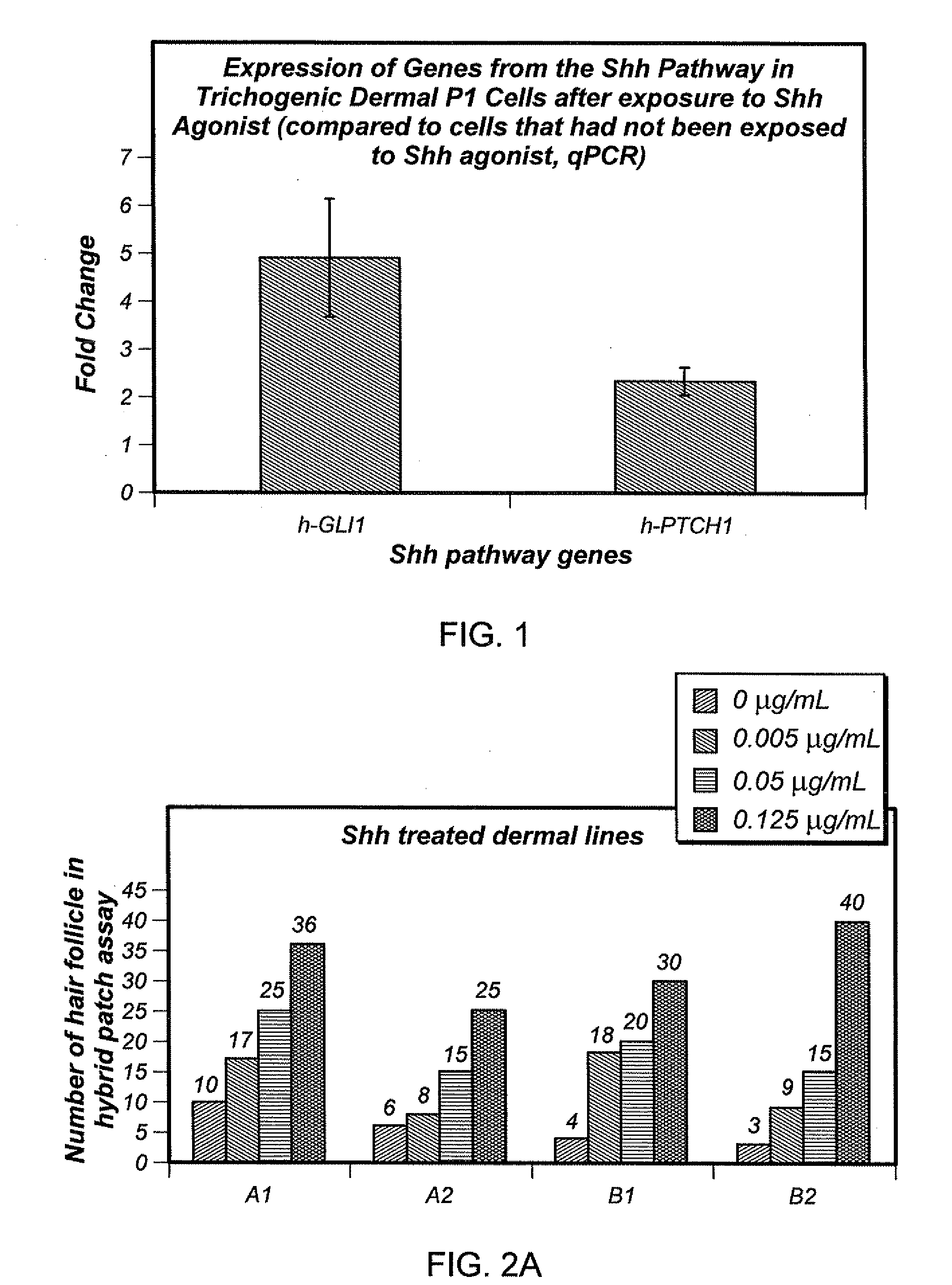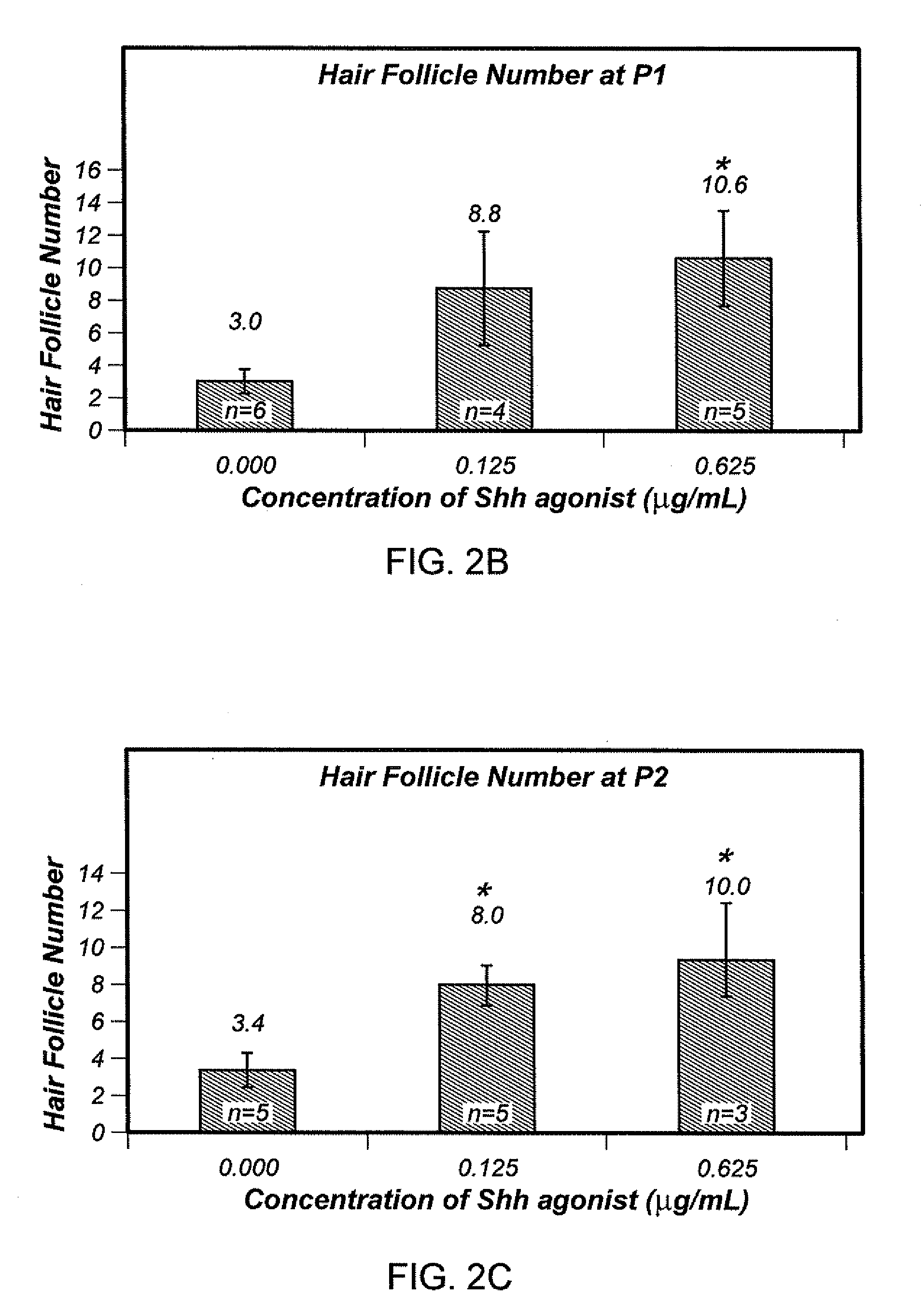Methods and compositions for increasing trichogenic potency of dermal cells
- Summary
- Abstract
- Description
- Claims
- Application Information
AI Technical Summary
Benefits of technology
Problems solved by technology
Method used
Image
Examples
example 1
Stimulation of the Sonic Hedgehog Pathway
[0077]Cell Culture
[0078]Cell dissociation can be obtained using any known procedure, including treatment with enzymes such as trypsin and collagenase, or by using physical methods of dissociation such as with a blunt instrument or by mincing with a scalpel to a allow outgrowth of specific cell types from a tissue.
[0079]Dissociated cells can be placed into any known culture medium capable of supporting cell growth, including MEM, DMEM, and RPMI, F-12, containing supplements which are required for cellular metabolism such as glutamine and other amino acids, vitamins, minerals and useful proteins such as transferrin. Medium may also contain antibiotics to prevent contamination with yeast, bacteria and fungi such as penicillin, streptomycin, and gentamicin. In some cases, the medium may contain serum derived from bovine, equine, or chicken. A particularly preferable medium for cells is a mixture of DMEM and F-12.
[0080]Shh pathway agonist(s) can b...
example 2
Dose Response of the Compounds Used and the Bioassay
[0083]Aderans Hair Patch Assay™
[0084]Trichogenic activity of populations of dermal cells was determined by the Aderans Hair Patch Assay™ (Zheng, Y., J Invest Dermatol, 124: 867-876 (2005)). In this assay dissociated dermal and epidermal cells are implanted into the dermis or the subcutis of an immunoincompetent mouse. Using mouse newborn skin cells, new hair follicles typically form in this assay within 8 to 10 days. The newly formed follicle manifests normal hair shafts, mature sebaceous glands, and a natural hair cycle. Although normal cycling hair follicles are formed in this assay, the assay primarily measures the ability of cells or combinations of cells to form new follicles. In the classical Patch assay mouse neonatal dermal cells were assayed in conjunction with mouse neonatal epidermal cells. In a modification of that assay human adult dermal cells are assayed in the presence of mouse newborn epidermal cells.
[0085]Results
[...
example 3
Cell Inductivity with Short-Term Treatment
[0088]To investigate if Shh pathway agonist can increase cell inductivity with short-term treatment (7 days before harvest); 3 patient samples were tested using agonist B. For each sample, the cells were treated with 0, 0.0125, 0.0375, 0.05 and 0.15 ug / ml of Shh pathway agonist B at the passage P1 or P2. P1 and P2 cells were then harvested after approximately 7 days and analyzed in the hybrid patch assay. Similar results were seen in these short-term treated samples (FIGS. 6A and 6B), where all Shh pathway agonist B treated cells gave higher hair follicle numbers compared to the control. In this study the middle concentration (0.0375 μg / ml) proved to be the optimal for P1 and P2 cells. The middle concentration of Shh pathway agonist B increased hair follicle number in a short term treatment (7 days). Cells were treated for that 7 day period only, but not treated prior to that. The continuous treatment results are shown in FIG. 4. The short t...
PUM
 Login to View More
Login to View More Abstract
Description
Claims
Application Information
 Login to View More
Login to View More - R&D
- Intellectual Property
- Life Sciences
- Materials
- Tech Scout
- Unparalleled Data Quality
- Higher Quality Content
- 60% Fewer Hallucinations
Browse by: Latest US Patents, China's latest patents, Technical Efficacy Thesaurus, Application Domain, Technology Topic, Popular Technical Reports.
© 2025 PatSnap. All rights reserved.Legal|Privacy policy|Modern Slavery Act Transparency Statement|Sitemap|About US| Contact US: help@patsnap.com



